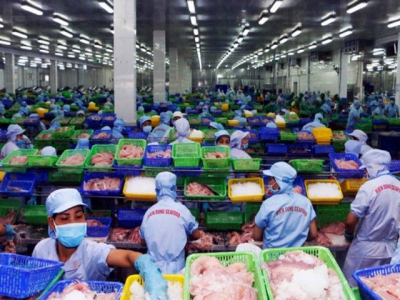Fisheries sector sets sights on US$16 bln export target by 2030

The Vietnamese aquatic sector has set an export target of approximately US$8.6 billion for this year and US$16 billion by 2030, according to information released by the Ministry of Industry and Trade.
Despite suffering from an adverse impact caused by the COVID-19 pandemic, Vietnam exported 806,200 tonnes of aquatic products abroad worth US$3.239 billion during the opening five months of the year, up 13.39% in volume and 12.46% in value, compared to the same period last year.
Most notably, the export of pangasius, basa, shrimp, tuna, octopus, and clams enjoyed strong growth in terms of volume.
Vietnamese seafood exports, especially high-end products to the EU and the United States, are anticipated to increase as these markets reopen following the pandemic.
Meanwhile, some major suppliers such as India and others in Southeast Asia and South America have been heavily affected by the pandemic, a factor which will create greater opportunities for Vietnamese exporters in the time ahead.
According experts, the fisheries sector is likely to continue facing numerous difficulties in the near future as the pandemic continues to disrupt the distribution channels of seafood products in major export markets due to the COVID-19 pandemic, thereby leading to a decrease in the price of products.
Moreover, the European Commission (EC) has not yet removed the yellow card warning placed on the Vietnamese fishing industry which has had a hugely adverse impact on local seafood exports
Bui Van Khang, vice chairman of the Quang Ninh People's Committee, points out that there is generally a lack of linkages among processing facilities, raw material areas, and seafood processing enterprises.
Experts therefore underline the importance of applying science and technology in breeding activities and post-harvest preservation as a means of meeting the stringent requirements set by importers.
They also emphasize the need to restructure seafood processing enterprises in line with the circular economy model in a bid to improve product value.
Deputy Minister of Agriculture and Rural Development Phung Duc Tien suggests that businesses exploit seafood products in a sustainable manner, with a specific focus on three pillars: exploitation, preservation and farming in association with processing that can fulfill the targets set by the sector.
Related news
 Beyond salmon - three species seen as suitable for RAS
Beyond salmon - three species seen as suitable for RAS Catfish, grouper and shrimp all have huge potential to be grown in recirculating aquaculture systems (RAS).
 Creating all-female catfish without the use of hormones
Creating all-female catfish without the use of hormones The prospect of ongrowing only female – and therefore faster-growing – catfish could be a step closer.
 Wastewater breakthrough could fuel North Carolina aquaculture boom
Wastewater breakthrough could fuel North Carolina aquaculture boom A project that aims to overcome barriers to growth in North Carolina’s aquaculture industry and strengthen the resiliency of the state’s wastewater